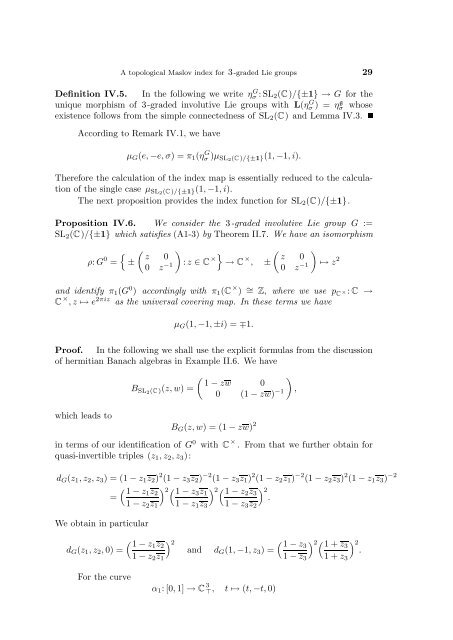A topological Maslov index for 3-graded Lie groups - ResearchGate
A topological Maslov index for 3-graded Lie groups - ResearchGate
A topological Maslov index for 3-graded Lie groups - ResearchGate
Create successful ePaper yourself
Turn your PDF publications into a flip-book with our unique Google optimized e-Paper software.
A <strong>topological</strong> <strong>Maslov</strong> <strong>index</strong> <strong>for</strong> 3-<strong>graded</strong> <strong>Lie</strong> <strong>groups</strong> 29<br />
Definition IV.5. In the following we write η G σ : SL2(C)/{±1} → G <strong>for</strong> the<br />
unique morphism of 3-<strong>graded</strong> involutive <strong>Lie</strong> <strong>groups</strong> with L(η G σ ) = ηg σ whose<br />
existence follows from the simple connectedness of SL2(C) and Lemma IV.3.<br />
According to Remark IV.1, we have<br />
µG(e, −e, σ) = π1(η G σ )µ SL2(C)/{±1}(1, −1, i).<br />
There<strong>for</strong>e the calculation of the <strong>index</strong> map is essentially reduced to the calculation<br />
of the single case µ SL2(C)/{±1}(1, −1, i).<br />
The next proposition provides the <strong>index</strong> function <strong>for</strong> SL2(C)/{±1}.<br />
Proposition IV.6. We consider the 3-<strong>graded</strong> involutive <strong>Lie</strong> group G :=<br />
SL2(C)/{±1} which satisfies (A1-3) by Theorem II.7. We have an isomorphism<br />
ρ: G 0 <br />
= ±<br />
<br />
z 0<br />
0 z−1 <br />
: z ∈ C ×<br />
→ C × <br />
z 0<br />
, ±<br />
0 z−1 <br />
↦→ z 2<br />
and identify π1(G 0 ) accordingly with π1(C × ) ∼ = Z, where we use p C ×: C →<br />
C × , z ↦→ e 2πiz as the universal covering map. In these terms we have<br />
µG(1, −1, ±i) = ∓1.<br />
Proof. In the following we shall use the explicit <strong>for</strong>mulas from the discussion<br />
of hermitian Banach algebras in Example II.6. We have<br />
which leads to<br />
B SL2(C)(z, w) =<br />
<br />
1 − zw 0<br />
0 (1 − zw) −1<br />
<br />
,<br />
BG(z, w) = (1 − zw) 2<br />
in terms of our identification of G 0 with C × . From that we further obtain <strong>for</strong><br />
quasi-invertible triples (z1, z2, z3):<br />
dG(z1, z2, z3) = (1 − z1z2) 2 (1 − z3z2) −2 (1 − z3z1) 2 (1 − z2z1) −2 (1 − z2z3) 2 (1 − z1z3) −2<br />
We obtain in particular<br />
<br />
1 −<br />
<br />
z1z2 2<br />
1 −<br />
<br />
z3z1 2<br />
1 − z2z3<br />
=<br />
1 − z2z1 1 − z1z3 1 − z3z2<br />
<br />
1 − z1z2<br />
dG(z1, z2, 0) =<br />
1 − z2z1<br />
For the curve<br />
2<br />
2<br />
.<br />
<br />
1 −<br />
<br />
z3 2<br />
1 + z3<br />
and dG(1, −1, z3) =<br />
1 − z3 1 + z3<br />
α1: [0, 1] → C 3 ⊤ , t ↦→ (t, −t, 0)<br />
2<br />
.

















